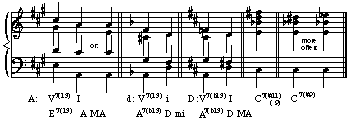
Extended Tertian Chords
"Tertian" means built with thirds: thus, extended tertian chords simply are those which go beyond 7th chords: 9th, 11th, and 13th chords. These sonorities generally are used as dominant chords: it's best to think of a "core" Mm7 chord with a "color note" (or several) added onto it. They're almost always used in root position, though inversions are possible. This handout includes information about the "legit," classical use of these chords. As you know, extended tertian chords are particularly prominent in jazz, the theory of which lies well beyond the scope of this handout.
Ninth Chords
- Dominant ninth chords occur pretty frequently. The ninth of the chord may be diatonic in the key (V9) or it may be chromatically altered (often Vb9, sometimes V#9, especially in jazz). These chords are simply called "dominant ninth chord, flat ninth chord, and sharp ninth chord" respectively. Some theorists call them MmM9, Mmm9, and Mm+9, based on the quality of the 7th chord (Mm) and of the 9th (M or m or +9) above the root. Secondary dominant 9ths are possible (e.g. V9/V).
- Nondominant ninth chords are so called because the core seventh chord is not a Mm7. There are two basic qualities: mmM9 or MMM9. The first is often called a "minor ninth chord" and usually has a predominant function, like ii9 in a major key. The second is often called a "major ninth chord" and sometimes has a tonic function, like I9 in a major key.
- Partwriting considerations
Spacing: is usually fairly wide (open). The 9th is frequently found in the top voice (the melody) and is at least a 9th (sometimes a 16th) above the root.
Voicing: in SATB (four-voice) writing, generally omit the fifth of the chord.
Resolving: in the progression V9 - I, the 9th resolves down by step (just like the seventh).
Eleventh Chords
- As with ninth chords, eleventh chords may occur on any scale degree. The V11 is by far the most common. The V11 is usually called a "dominant eleventh chord"; some might label it MmMP11. It's possible to have something like a ii11 chord: mmMP11. Jazz frequently has "sharp eleventh chords"--a V#11, or MmM+11, and a I#11, or MMM+11. Secondary dominant 11ths (e.g. V11/V) are possible.
- Partwriting considerations
Spacing: is usually quite wide (open). The 11th is almost always found in the top voice (the melody) and is at least an 11th (sometimes an 18th) above the root.
Voicing: in SATB (four-voice) writing, omit the third and the ninth; unlike the 9th and 13th chords, the third is omitted here because it produces a dissonance with the 11th.
Resolving: in the progression V11 - I, the 11th is usually held as a common tone.
Thirteenth Chords
- Thirteenth chords almost always function as dominant chords. The thirteenth of the chord may be diatonic in the key (V13) or it may be chromatically altered (Vb13). These chords are usually simply called "dominant thirteenth chord" and "flat thirteenth chord." Some theorists call them MmMPM13 and MmMPm13. Secondary dominant 13ths are possible (e.g. V13/V).
- Partwriting considerations Spacing: is usually quite wide (open). The
13th is almost always found in the top voice (the melody) and is at least
an 13th (sometimes a 20th) above the root.
Voicing: in SATB (four-voice) writing, omit the fifth, the ninth, and the eleventh (in other words, use the "core" root, third, and seventh, and add the thirteenth).
Resolving: in the progression V13 - I, the 13th usually leaps down a third upon resolution. There sometimes will be a PT inserted in between.
A quick summary: usually dominant-functioning chords, usually root position, frequently wide spacing, usually write the "core" Mm7 (the root, 3rd, and 7th) and add the "color note" (9th, 11th, or 13th). 11th chords are an exception--use the root, 5th, 7th, and 11th. 9th usually resolves down by step, 11th usually a common tone, 13th usually resolves down a third (often a PT inserted). Labels: Roman numerals (e.g. Vb13), jazz/pop (e.g. C#11), specific quality (e.g. G MmMPM13).
Dominant sound ("core" Mm7 with a "color note" added):


Predominant sound, Tonic A progression including several of them:
